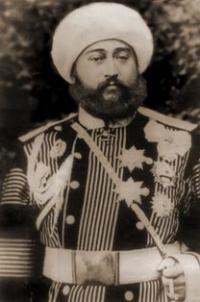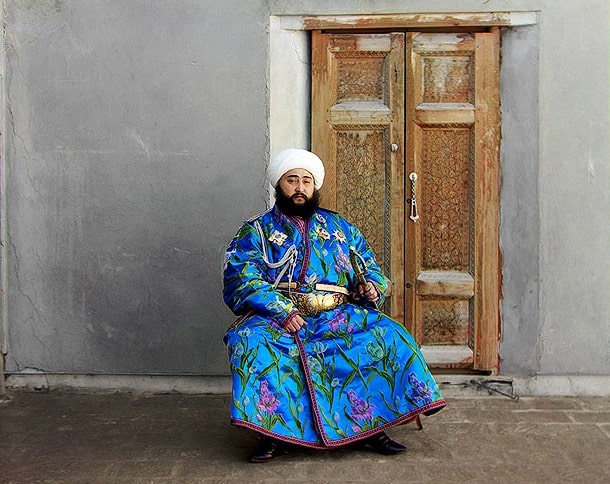You are here
Sayid Amir Alim Khan.

Tours Silk Road and Uzbekistan.
“If diversity is a source of wonder, its opposite - the ubiquitous condensation to some blandly amorphous and singulary generic modern culture that takes for granted an impoverished environment - is a source of dismay. There is, indeed, a fire burning over the earth, taking with it plants and animals, cultures, languages, ancient skills and visionary wisdom. Quelling this flame, and re-inventing the poetry of diversity is perhaps the most importent challenge of our times”
Wade Davis.
Outstanding personalities of Uzbekistan.
The second son of Bukhara amir from the mangyt dynasty Sayyid Abdullahad Khan (1885 - 1910) Tyura-jan Mir-Alim was born on January 3, 1880. His grandfather Amir Muzaffar-khan (1860 - 1885) recognized the protectorate Of Russia over the Khanate of Bukhara, having signed the corresponding political agreements in 1868 and 1873.
According to the court etiquette of the Russian royal court, the amirs of Bukhara had the title of “luminosity” and stood above the great princes. In January 1893, Mir-Alim and his father arrived in St. Petersburg, where he was determined to study at the elite imperial higher military educational institution - Nikolaev Cadet Corps.
Emperor Alexander III approved Mir-Alim as the heir to the throne and personally determined the program of his education, promising Adullahad Khan that his son would be brought up in accordance with the norms of Islam.
Mir-Alim studied in St. Petersburg until the summer of 1896, under the supervision of Osman-bek guard-begi and personal tutor Colonel Demin. The throne of the father, Sayid Alim Khan, occupied December 4, 1910.
Already the next year after assuming the throne, Amir Alim Khan received from Emperor Nicholas II the rank of major general of the tsarist army and the rank of adjutant adjutant, and in late 1915 he was promoted to lieutenant general and adjutant general.
In September 1916 he was awarded one of the highest Russian awards - the Order of Alexander Nevsky. He owned property in Russia: cottages-palaces in the Crimea, Kislovodsk, Zheleznovodsk, at home in St. Petersburg.
March 11, 1913 in the Ministry of Foreign Affairs of Russia, and on June 14, 1914, the meeting of the State Duma of Russia raised the issue of reforming the administrative structure of the Bukhara Khanate and its annexation to Russia.
However, Nicholas II rejected these proposals. Alim Khan is the son of a general from cavalry and Adjutant General of the Russian service of the Emir of Bukhara, Seid-Abdul Ahad Khan. Hereditary ruler of the Bukhara Emirate (on the territory of modern Uzbekistan, Tajikistan and Turkmenistan; until 1917, the protectorate of Russia; 2.5 - 3 million subjects, personal fortune - 150 million rubles in gold).
Educated in Nikolaevsk Cadet Corps. Without graduation, the school was enrolled in the Terek KV Khorunzhim (Art. 23.04.1896). The centurion (art. 18.05.1898). Podlesaul (v. 11/23/1901). In 1902 he was granted the title of His Grace, and after taking the throne (after the death of his father 12/22/1910) - His Highness. Esaul (v. 06.12.1903).
Appointed out-adjutant (06/06/1905). Military sergeant (art. 11/21/1906). Colonel (art. 12/06/1909). Major General (Art. 13/05/1911) with the appointment of His Majesty in retinue. Lieutenant-General (f. 30.12.1915; art. 30.12.1915; in the List the generals on 10.07.1916 are listed as Major General (Art. 30.07.1910) with an appointment as adjutant-general.
In 1914, 1915 and 1916, he donated 1 million rubles in gold "for the victory of the Russian weapon." On 07/10/1916 was listed in the Orenburg Cossack army. 03/25/1918 concluded a peace treaty with the RSFSR.
He maintained contacts with the UK government, Orenburg ataman A.I. Dutov, Kokand autonomy, Transcaspian interim government, from autumn 1919 - with the Omsk government of Admiral A.V. Kolchak. He negotiated with the Khiva Khanate on joint military actions against the Turkestan Soviet Republic, at 01.1920 concluded a military alliance with Afghanistan.
By decree of 07/07/1920, he called on subjects for a holy war against the Bolsheviks. Awards: Order of St. Stanislav 2nd degree. with a star (1898); St. Stanislav 1st century. with diamonds (1901), St. Anne 1st century. (1906); St. Vladimir 2nd century. (1910); White Eagle with diamonds (1911); St. Alexander Nevsky (01.09.1916).
Other awards: the code of His Imperial Majesty, adorned with diamonds (1896); checker with diamonds (1902); a portrait of His Imperial Majesty, adorned with diamonds, for wearing on his chest (1913). Highest thanks: sincere thanks to His Majesty in the Supreme Rescript (1913).
The seizure of power in Russia by the Bolsheviks in 1917 allowed Amir Alim Khan to declare full sovereignty and annul the 1873 treaty on the protectorate of Russia. March 23, 1918 Alim Khan signed a peace treaty with the RSFSR. However, conscious of the military threat of the Bolsheviks, he began to intensively strengthen the Bukhara army.
For this, Russian and Turkish officers who had combat experience were recruited. The Turkish and Afghan "volunteers" formed infantry and cavalry regiments. Amir made two military mobilization, authorized the production of melee weapons and ammunition.
By August 1920, the army of the Amirat consisted of up to 60 thousand fighters, including 15 thousand infantry, 35 thousand cavalry, 55 guns, several dozen machine guns. Nevertheless, as a result of the Bukhara “revolution”, secured by the invasion of Amir’s forces by the Soviet troops of the Turkfronts under the command of Frunze, the Amir’s army was defeated.
On September 2, 1920, units of the Red Army of the RSFSR occupied Bukhara and sayid Alim Khan was dethroned. On the territory of Bukhara, the People’s Soviet Republic of Bukhara was proclaimed (1920 - 1924).
From September 1920 to February 1921, Alim Khan was in the territory of Eastern Bukhara, trying to organize a counteroffensive against the Soviets. Amir Sayyid Alim Khan managed to gather significant military forces in the areas of Kulyab, Gissar and Dushanbe. In mid-November 1920, his troops moved west and occupied Baysun, Derbend and Sherabad.
By the end of 1920 and the beginning of 1921, the number of military forces of Sayyid Alim Khan reached 10 thousand people. Ibrahim-bek detachments based in the area of Lokaya joined Alim Khan's army. On the basis of an agreement between the Bukhara Republic and the RSFSR against Alim Khan, a special Gissar military expedition was organized, as a result of which his forces were defeated and he was forced to flee to Afghanistan.
First, Alim Khan stopped in Khanabad, and in May 1921 he arrived in Kabul. Amir of Afghanistan, who had an agreement with the RSFSR, identified Alim Khan with the status of an honorary prisoner with an annual allocation of funds for his maintenance.
His three sons remained on Soviet territory. Two of them Sultanmurad and Rahim were later killed, and the third Shokhmurad in 1929 publicly renounced his father. Alim Khan died in 1943 in Kabul.

Enlightener:
Aleksei Arapovв. http://www.alexarapov.narod.ru







